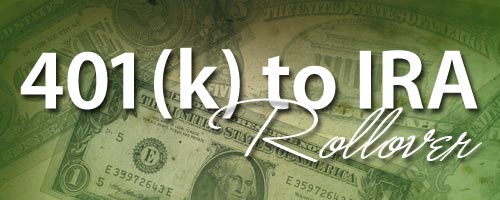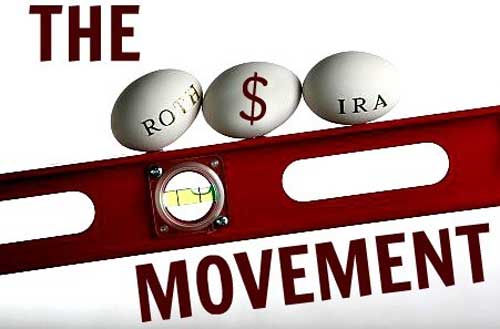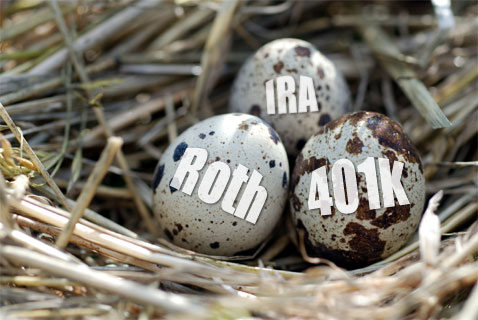When you leave a job for whatever reason it can be a tough time in your life, a time of transition and a lot of change. All of the new things going on around you can be distracting, and if you're not careful it can lead to you not doing some things that need to be done.
One of the things that a lot of people don't really think about right away is rolling over their own company 401(k) to a new IRA retirement account. While it may not be the first priority on your list, doing a 401(k) rollover should definitely be on your punch list, especially if your old company 401(k) is in a plan that doesn't offer a lot of low cost options.

What Can You Do With Your 401(k) After Moving Jobs?
When it comes to your 401(k) there are several options of what you can do with your funds.
- Just leave it alone: A lot of people will just leave their old company 401(k) in the account with the plan administrator, and not move it at all. While this can be an OK idea if you've got some great low cost options for investments in your old plan, for most people it makes better financial sense to just move the account to their own IRA with a brokerage or mutual fund company.
- Take the money and run: Some people will take their account balance and just cash it out. This isn't an ideal plan, however, because if you're not 59 1/2, you'll have to pay state and federal tax rates, along with a 10% early withdrawal penalty. After all is said and done you could be left with just over half your money after you pay your taxes and penalties. Who would want that?
- Transfer funds to a new 401(k): Some people may find a new job and get a new 401(k) right away. If you do, you may be able to roll the funds over to the new plan. Just make sure it's a good plan with low costs. For most people, however, their best option is the one below, rolling the old 401(k) into an IRA.
- Roll the 401(k) into an IRA: Rolling over your 401(k) to an IRA that you've set up at an external brokerage or mutual fund company is probably going to be your most ideal situation. You'll have a plan with more options, probably less costs and you'll have a whole lot more control. Check out FiPath's new rollover tool through the link to the right for help in finding a company to work with.
So for most people the best option is to do a 401(k) rollover to a good low cost IRA.
Why Would You Want To Do A 401(k) Rollover?
So what are the main reasons why you would want to roll over your 401(k) upon leaving your old job?
- 401(k) plan investment options are usually limited: When you have a company 401(k) usually there is a plan administrator who chooses what funds to include in your company's plan. Some plans only offer limited choices with one option for index funds, maybe no international exposure, etc. Rolling over your funds allows you to choose better investments that are more suited to your situation.
- 401(k) plans have higher costs: The funds that have been pre-selected in your 401(k) by your plan administrator won't often be the best or lowest costs funds unfortunately. The expense ratios can often be quite outrageous. Besides that there are sometimes annual management fees or other miscellaneous fund fees. Move your funds to an IRA where you can better manage your costs with low cost fund options.
In some cases you may not want to do a 401(k) rollover. For example, if you're retiring early, planning a Roth conversion, or situations where you're dealing with a large amount of company stock. But those situations aren't very common. So let's move on to the next step, doing a 401(k) rollover, step by step.
401(k) Rollover Step By Step
Here is a step by step look at what you need to do when performing an 401k rollover to an IRA.
- Open your IRA: The first step is to open an IRA at the company of your choice, be it a brokerage or mutual fund company. Here's how to choose a IRA custodian.
- Get the forms your old 401(k) provider: First confirm that you don't have any restrictions on rolling funds over, and then request the forms that you'll need in order to get the ball rolling. When talking to your contacts, make sure to ask what information exactly that you'll need from your new IRA in order to do the transfer.
- Verify account setup with new IRA provider: Talk to someone with your new IRA custodian to ensure that your account is ready to receive transferred funds. Make sure you have everything you need to fill out the forms from your old 401(k)'s company.
- Fill out the 401(k) transfer paperwork: Fill out the paperwork that you received from your old plan's administrators, making sure that you have filled everything out completely. When you're satisfied that the paperwork is complete, submit it and wait for your funds to be transferred.
- Verify direct rollover of funds: Make sure that you ask the old 401k company to do a direct rollover of funds, and not an indirect rollover. The difference is that with a direct rollover a check goes directly to the new IRA custodian, and you don't have to worry about taxes/etc. With an indirect rollover the check would be made out to you, with 20% taxes withheld, and then you are required to deposit the entire amount of the old 401(k) balance (by adding in your own money to compensate for withheld taxes) to the new IRA within 60 days. If you don't you'll be subject too taxes and penalties for early withdrawal. As long as you do deposit the entire balance you'll receive the amount withheld when you file taxes.
Doing A 401(k) Rollover Shouldn't Be Too Painful
Moving on from an old job can be a stressful time, and the things associated with finding a new job, moving, and so on can take up a lot of time. In the meantime doing things that don't seem that important, like rolling over a 401(k), can get pushed to the back burner. But it's still important to investigate your options when it comes to moving your account balance. In the long run it can be a difference of thousands of dollars.
So after immediate concerns have died down look into your options. In most situations that means rolling over your 401(k) funds into a new IRA account with a discount brokerage, mutual fund company or a company like Betterment.com. Just make sure that you don't let your money sit in an old account with high fees and no good investment options for too long. Good luck!
Rollover your old 401(k) now. FiPath’s new rollover tool will let you find your perfect provider to roll over your 401(k) to an IRA in minutes. Get started!

